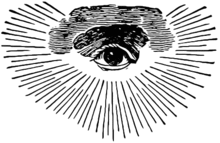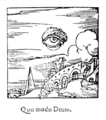Eye of providence

The Eye of Providence (also all-seeing eye, eye of God, or God's eye) is a symbol that is usually interpreted as the eye of God that sees everything. It is depicted as an eye surrounded by a halo and is usually enclosed by a triangle that refers to the Trinity . This triangle also includes the aspects that are said to be associated with the number three , which from ancient times was known as the approximation of the circle number and was therefore considered a sacred, "divine" number.
origin
The sun eye

In early Egyptian mythology , for example , the sun's eye of Re was placed in or above a picture of a false door oriented to the east . This symbolism is often used in the groove book . The sun god Re takes the form of a falcon shortly before sunrise and thus slips into the role of " Horus in the horizon ". The later naming of Osiris as "his father" shows that Re is actually understood as Horus . The appearance as "Horus in the horizon" is connected with the process of rebirth . According to the ideas based on the ancient Egyptian religion , the deceased walked through the false door to be reborn every day, similar to Re.
In Indian mythology the sun's eye appears in the form of the deity Surya , in Zoroastrianism as the eye of Mithra .
The moon eye
In the Old Kingdom, the moon god Thoth took second place behind Re and was given the names "Wesir des Re", "Scribe des Re" and "Child of Re". As the moon, Thoth received the secondary designation " silver sun " and was at the same time lord of the moon's eye.
The background to the role of protector and savior of the moon eye is the Osiris myth : He found the missing injured eye and healed it. His parallels become particularly clear when compared as a cosmic being: "Thoth as god of light and moon arises from the dark chaos of Seth ". The moon eye symbolically stands for regeneration, renewal and healing.
Zurvanism
Already in the 4th century BC, Zurvanism placed a third, almighty god above the two gods of dualistic Zoroastrianism : Zurvan Akarano was the god of time and space and the father of Ahura Mazda , the god of wisdom and of Ahriman , the god of evil. Zurvan was symbolized by the so-called eye of prophecy in a triangle, which symbolizes the triune time in the form of past, present and future or growth, fertility and aging.
Judaism and Christianity

In the Bible, too, the eye appears as a symbol of God's omnipresence . So it says in the Old Testament in Prov. 15,3 EU : "In every place are the eyes of the Lord, they watch over good and bad."
The painting Last Supper in Emmaus by Jacopo da Pontormo shows the divine eye enclosed by a triangle as a symbol of the Trinity .
Different illustrations of the first complete editions of the work of the mystic Jakob Böhme in Holland, Germany and England in the second half of the 17th century formed the style for the symbol of the Eye of God . A representation of the Eye of God in a triangle, a symbol of the Trinity , can also be found on a medal of the English King Charles II from 1660. Here, too, authors such as Christoph Geissmar suspect that this medal was created with the transfer of the writings Jacob Boehmes could be related to English.
“In 1677 the eye of God met in a triangle with a cloud ring in the crowning of the Holy Cross altar of the northern cross chapel of the Springborn monastery (sculptor Joh. Schmitt ) in Rößel (Poland); 1683 on the German (Austrian) medal on the first siege of Vienna; 1690 again on an English medal of King Wilhelm III. (1689-1702). As a result, the eye of God is omnipresent, so to speak, with and without a triangle "
The chapel-like wayside shrine, Eye of God, on the Rheinwesterwald volcanic ridge belonging to the Niederwesterwald , in the area of the local community Rheinbreitbach in the Rhineland-Palatinate district of Neuwied, is named after the symbol.
Freemasonry

The Eye of Providence also appears as part of Masonic symbolism and was adopted from church customs. In many Masonic lodges it shines in the "east" above the master's chair and often plays a role in the master's degree, especially in the systems that emphasize the esoteric aspect. Often the Masonic Eye of Providence has half a halo below the eye - the lowest rays are often extended downwards.
The open eye symbolizes the truth that is always revealed, calls for wisdom and appeals to the conscience. Via causality as a cause-and-effect principle, it represents the good that places evil in order to defeat it. Christian Masonic lodges in particular use a quotation from the Bible ( Jn 1,1 EU ) to point out the ambiguous concept of the logos , which is equated with the almighty master builder of all worlds and primarily represents the rational principle of the universe. The eye is therefore also replaced by a “G”, the meaning of which is just as varied.
The eye is often enclosed in a triangle. It is the sign of fire and enlightening science and is used to measure the greatest distances , but also the trinity in Christianity. The triangle is understood here as a reference to the Masonic number three in numerology . The first official Masonic mention of the symbol Eye of Providence was in 1772 in the book Illustrations of Masonry by William Preston (1742-1818).
Illuminati
Today's conspiracy theorists associate the symbol with secret societies , particularly with the Bavarian Illuminati secret society founded in 1776 by Ingolstadt professor Adam Weishaupt .
A connection between the seal of the United States and the Illuminati cannot be proven. Until they were banned by the Bavarian Elector Karl Theodor in 1784/1785 , the Illuminati had a maximum of 2500 members and mostly won them from German Masonic lodges. Many were arrested on the grounds that they were "notorious free thinkers ". Under the Freemason Johann Joachim Christoph Bode , the religious activities in the Weimar Minerval Church came to an end in 1785.
United States
In 1782, the Eye of Providence became part of the symbolism on the reverse of the United States seal and was introduced by the 1776 design committee. The idea of using the all-seeing eye in the halo goes back to a suggestion by the artistic advisor Pierre Eugène du Simitière . The pyramid (without the all-seeing eye) is by Francis Hopkinson , who originally designed it in 1778 for a 50-dollar bill that was in circulation at the time. In 1782, William Barton finally merged these two symbols to form the Eye of Providence above the pyramid. The coat of arms is used on United States documents. The Eye of Providence is also on the back of the one dollar bill .
gallery
Woodcut of alchemy with the all-seeing eye
Eye of Providence over the French Declaration of Human and Civil Rights 1789
Eye of Providence in the talking arms of the Jauch
Bad Krozingen coat of arms
Coat of arms of Litzelsdorf (Austria)
literature
- Christoph Geissmar : The Eye of God - Pictures to Jakob Böhme . Wiesbaden 1993
- Georg Stuhlfauth : The triangle - the story of a religious symbol. Stuttgart 1937.
- Alexandra von Lieven : Floor plan of the course of the stars - the so-called groove book . The Carsten Niebuhr Institute of Ancient Eastern Studies (among others), Copenhagen 2007, ISBN 978-87-635-0406-5
- Aloys Henning: On the symbolic language of the eye in mythology and history. In: Würzburger medical history reports 24, 2005, pp. 329-340
Web links
Individual evidence
- ↑ 1 Kings 7,23-26 EU : In this description the three is indirectly found as an approximation to the circle number.
- ↑ Cf. Tycho Q. Mrsich: Questions about the ancient Egyptian law of the "period of isolation" before the New Reich - a research report from the working group "Historiogenesis of legal norms" , Utz, Munich 2005, § 33.
- ↑ Image of the painting on the Uffizi Gallery , accessed on May 26, 2017.
- ↑ Eugen Lennhoff, Oskar Posner, Dieter A. Binder: Internationales Freemaurerlexikon. FA Herbig, 2000, p. 96.
- ↑ Illustrations of Masonry. ( Memento of the original from February 2, 2014 in the Internet Archive ) Info: The archive link was inserted automatically and has not yet been checked. Please check the original and archive link according to the instructions and then remove this notice. (PDF; Illustrations of Masonry , by William Preston (1742–1818))









